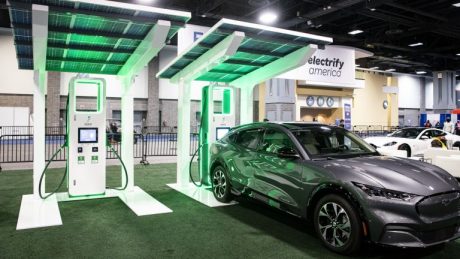Gas-n-Go vs. Recharge of EV

By Dexter Liu
Editor’s note: A regular contributor to this newspaper, Mr. Liu holds multiple patents and is well-qualified to tackle this complex subject.
USA – Those considering buying an electric vehicle (EV) should do some serious research, perhaps even some soul searching. For example, did you know that driving your new EV to grandma’s for Thanksgiving may require more intense trip planning and more travel time than you’re used to? That’s because after buying into what you’ve been told is the “future of transportation,” you now need to factor usable range and battery recharging times into your travel plans.
Your new electric wheels will subject you to a level of trip-planning strategy you’ve never before experienced. Politicians promise to build a more extensive EV-charging infrastructure (paid with your tax dollars), but how soon until the lines at charging stations become an intolerable nuisance? Some of us remember long lines at the pump during President Jimmy Carter’s gas crisis.
It certainly seems the whole world is told to jump onboard the EV band wagon, however, keep in mind recharging EVs takes a lot longer than pumping gas. Nevertheless, going electric means you’ve now joined the exclusive club of “socially responsible e-motorists!” Of course, this elite group pays for the privilege by living with an affliction known as “Range Anxiety.”
True, the onboard e-smarts helps you plan trips better than the ole’ Rand McNally, but on those extended road trips you had better pack a few more pairs of underwear for those extra nights waiting to top off your battery!
A typical public charging station is a “Level 2” charger. It’s better than the basic “Level 1” that comes with the initial EV purchase and plugs into a standard outlet at 110 or 120 volts. That option could take more than 48 hours to charge an EV with a 200-mile range.
A Level 2 charger, rated at 240 volts at 40 amps, is considerably better but still requires overnight charging to replenish a depleted battery – typically between 9 to 15 hours. Recharging times for entry level EVs can be 3 hours with an average 80-mile range, so on a Level 2 Charger, a full charge takes approximately 3 hours. A Level 2 charger requires one hour to produce just 22 to 25 miles of range.
It’s important to note that range calculations and recharging times may vary wildly depending on a host of other factors like traffic, weather, temperature, terrain, driving styles, full or partial loads, etc., because each of these elements may put a whole new wrinkle in calculating your range estimates. Suffice it to say, you’ll need to be on your toes and do the math to make it home without getting stranded.
With upscale luxury EVs, range can be more than 200 miles. The new Audi e-Tron GT is one example. With more battery range comes more charging time! For instance, the charging time for a depleted battery with a 200-mile range is 9 hours. The higher capacity luxury EVs like the Tesla Model S with a 405-mile range will take 16 hours on a Level 2. The new Lucid Air which claims a range of 520 miles will require more than 20 hours of charging time when its battery is depleted.
Those are significantly long recharging times unless, of course, you use the Level 3 “Super Charging Stations.” These chargers are commercial grade (too costly for most private homes) and much more expensive to run – so they are mostly provided by dealerships or institutions for their EV fleets. These chargers are capable of topping off a standard EV battery in one hour! But, did you know they actually shorten the useful life of your battery?
That’s because the rate at which the Super Charger “forces” the juice into your lithium-ion battery cells overheats them and accelerates deterioration, thus shortening its useful life. A typical EV battery has an average life expectancy of seven to nine years, but frequent Super Charger use can significantly shorten that life.
Battery life is definitely something to consider, particularly when replacement batteries are very expensive with entry level replacements running north of $5,000 to $7,000. Batteries for the luxury EVs may cost $10,000 to $13,000 (or more). Higher end models like the Tesla Model S could even run between $20,000 to $35,000!
The greater the range, the more kilowatt hour (KWH) capacity is required, which comes at a greater cost. Currently, the cost per KWH is averaging $150. Shopping for a used EV? Be wary of the battery’s remaining life. Replacing one in a used EV (that you thought was a bargain) may turn out to be quite a costly disappointment. The temptation is to search for cheap aftermarket replacement batteries, but word to the wise, you may be quite literally taking your life in your own hands when you risk non-factory spec sub-standard batteries that may be unreliable – or even defective – making them dangerous.
More about those scary battery fires later!

Dexter is a frequent contributor to the County Compass.










































